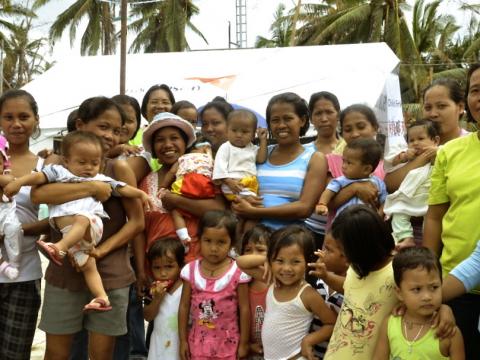Stronger than Haiyan

I’m at the Child-Friendly Space (CFS) in Tabogon. Laughter and joy rings through the air as children enjoy activities in this special space World Vision has created for them. Their mothers look on and nod with a thank you and a smile at every person who enters the premises with a World Vision logo on them.
It’s been almost a week since I arrived in the Philippines and the massiveness of the disaster still overwhelms me. But the thing that amazes me most is the resilience of the communities and their determination to survive. So I talk to the group of mothers about their experience while they wait near the CFS.
“It reached our village on Friday morning,” Nay, 35, starts the story while others pitch in, “We had already heard about it in the news and we were asked to evacuate to safer locations.
“We knew it was going to be a very big storm, but you really don’t know how big and disastrous it is until it reaches your home.
"The typhoon reached our village before we could get to a safer location. It started to blow the houses one by one.
"Most of us have husbands who go for work outside the village – mainly to the town. And they were not in the village that day. My husband was also at work [over 80 kilometres away], so I had to prepare for the emergency with my six children [ages 1-10]. It was the case for many mothers that day.”
“When you have children to carry with you, you can’t carry a lot of things. So I packed some food for my children and a towel to keep them dry.”
“We mothers huddled our children together and started to walk trying to hide them from the storm with our bodies as we searched for a safer place. Any other difficult situation we mothers would have helped each other, but this time all of us were facing the same disaster and we had to take care on our own.”
“I carried my two youngest children [ages 1 and 5] while the other four held onto me and walked with me. We reached one house where the mothers were gathered with their children, but couldn’t stay there for long, as the roof got blown away. We all started walking to the next house pausing here and there to avoid falling trees and branches and flying roofs. My 10-year-old daughter got hit on the head by a piece of roof and got injured.”
“At moments like this we [mothers] think only about our children’s safety. A mother would do anything to protect her children. And it gives us strength to take risks. I never even for a moment debated what if we perish. That’s not an option for a mother. We have to make sure our children survive.”
“We walked like this from one location to another until we were all gathered in one house with a stronger structure. We were all drenched from the rain. There was no medicine so I found some herbal leaves in the garden, crushed them and put it on my daughter’s head. The house became crowded with mothers and children until there was no room for us to sit. We all stayed standing holding our children in our arms. We kept praying for their safety. The air was filled with the cries of children because they were afraid and hungry. There was no space to put them to sleep. My four older ones sat on my feet and fell asleep holding onto my legs and I held my younger ones in my arms. All mothers stayed like that the whole night till morning.”
“The next day we could get out. But it was a horrible sight with trees pulled out from their roots and thrown around, demolished houses all over the place. Our roof had got completely blown off and all our clothes and everything that were in the house had got soaked in the rain.”
“We started to clean up and with the remaining parts of the house and with wood that we could find, started to build temporary sheds to keep our children safe. With no transportation and roads inaccessible, it took a few days for our husbands to reach back the village. My husband had walked the whole day from the town and reached the village on Monday – three days after the disaster.”
“We received food items from World Vision. It was a great comfort to us. We still have enough left.”
“The greatest need for us now is shelter. Many families use the polythene sacks for the roof. But when it rains (and it rains often) the water still leaks into the house. On such days we don’t have a place to sleep and the children keep awake.”
“But the main thing is we survived. We are so thankful to God for protecting us and our children through this. My husband returned to work in the town today.”
“This space (CFS) will help our children to enjoy and recover,” the mothers smile.
I smile.
Their children are in this space only because of their mothers were stubbornly determined to protect their lives. Mothers who refused to be defeated by a disaster; mothers whose strength is stronger than Haiyan.